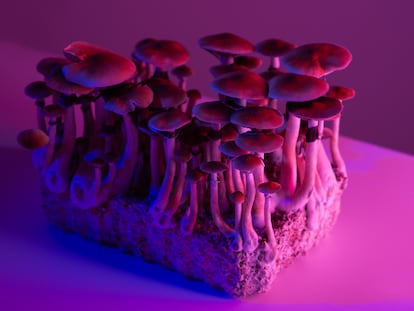Neuroscientist Mara Dierssen: ‘The brain regions that degenerate first are also the most plastic’
The Spanish brain expert talks to EL PAÍS about cognitive bias, stigmas about intellectual disabilities and how emotions influence decisions
Mara Dierssen, 61, skillfully explains the mysteries of the brain onstage at the first Festival of the Humanities held in late October in the seaside town of Dénia in eastern Spain. This neurobiologist, who hails from Santander in northern Spain, never fails to teach and delight, as Horace said, even when she’s singing with her pop-rock group – From Lost To The River. Dierssen, who works at the Center for Genomic Regulation in Barcelona, is a prominent Down syndrome researcher and a firm advocate of patient contact. EL PAÍS interviewed Dierssen after her talk at the Festival of the Humanities.
Question: What led you to study the brain?
Answer. As a child, I was exposed to my father’s [neurosurgeon Guillermo Dierssen] scientific methods and my mother’s [painter Trinidad Sotos] artistic sensitivity. I was also bilingual. I was accustomed to the structure of German that makes you wait until the end of the sentence before you can understand what it’s about. When I combined that with Spanish, which is more dynamic, I developed a certain mental flexibility. Our family would debate ideas at home on Sundays, which helped me developed critical thinking. That was the driving force for me to go into science. I wanted to study the brain, but not as a neurosurgeon. I am empathetic and sometimes become too emotionally invested in patients. That led me to translational neuroscience, which requires close and ongoing patient contact. I study Down syndrome, and I insist on knowing about the families that deal with this condition. You cannot understand a problem without knowing the people behind it.
Q. You stress the importance of emotion, which seems contrary to cerebral matters.
A. The oldest system in the brain is the emotional system. Emotions have tremendous adaptive value. We survive because we are afraid, which leads us to protect ourselves. We take pleasure in social relationships, which enables us to perpetuate the species. Emotion permeates all our systems. People who lack emotional capacity make poorer decisions. When making an important decision, it’s better to let yourself go. Don’t overthink it, because our brains tend to apply cognitive biases [processing information through a filter of personal experiences and preferences] when there’s too much information to process. When you buy a house, buy the one that made you exclaim, “This is the one I want!”
Q. Human beings have evolved due to brain plasticity. But can that capacity be our own worst enemy?
A. I wouldn’t say the worst because plasticity is very positive. But the brain’s capacity to change does make it more vulnerable. Brain plasticity is why we see genes linked to schizophrenia and genes that are risk factors for Alzheimer’s disease. The brain regions that degenerate first are also the most plastic regions. There is a certain relationship between plasticity and vulnerability.
Q. Some people with disorders also have extraordinary brains.
A. Differences in brain connectivity have been observed in such people, and some of their characteristics suggest that they have hyperconnected brains. Some people with Asperger’s syndrome are much more intelligent than the average person. There is a specific field of neuroscience research that focuses on extraordinary brains.
People who lack emotional capacity make poorer decisions
Q. A century ago, Spanish doctor Santiago Ramón y Cajal said the brain is a world consisting of a number of unexplored continents and great stretches of unknown territory. Does that still hold true?
A. Yes, although we know much more today. We still haven’t answered the fundamental question of how mental activity emerges from this amalgam of chemical, electrochemical and cellular systems. Or how the brain can work on all sorts of time scales, from nanoseconds to years, and from the atomic to the macroscopic. How do ideas arise? What about creativity?
Q. And spirituality?
A. The area of the brain that caused epileptic seizures has been surgically removed from patients successfully. But they must remain conscious during the procedure, which also enables us to develop of brain stimulation maps. We have seen cases of near-death and out-of-body experiences when certain areas of the brain are touched, and some people talk about having mystical experiences when an area of their brains is stimulated. It’s very possible that the human brain has a neural substrate, but it’s difficult to determine which one.
Q. Can you summarize your groundbreaking study of how green tea improves learning capacity in people with Down syndrome?
A. When learning happens, small biochemical changes occur in the cells that translate into plasticity at the structural level. This generates additional physical connections between neurons. We found that the brains of trisomic mice [having three copies of a given chromosome in each somatic cell instead of the usual two] were incapable of generating this plasticity. We then studied which genes could be related to this problem. We found one – the DYRK1A gene. Increasing the dose by 50% produced alterations in plasticity very similar to those observed in the mice. This is all very well, but you can’t do gene therapy with people. So we thought, “Let’s see if there is a compound that has an inhibiting effect on DYRK1A.” Sure enough, a molecule found in green tea reversed the cognitive alterations in the trisomic mouse. We did four trials that demonstrated some modest improvements in certain cognitive functions, adaptive capacity and part of the prefrontal functions related to language.
Q. Why are there stigmas about intellectual disabilities?
A. When people encounter something different, they innately reject it, and a sensation of fear is triggered. This can be overcome by acculturation – repeated exposure often reduces stigma. But it’s a concern because stereotypes limit opportunity. According to a study in Science, girls are told they’re not good at science from the time they’re six years old, when in fact they get better grades in math.
Q. What has your experience been as a woman and a scientist?
A. I have experienced some injustices – it’s a struggle that needs everyone’s involvement. Young women pursuing careers in science drop out along the way, because it’s very hard to combine motherhood with a career. But it’s not impossible – I have four children. I am fortunate because I have an intelligent husband who always supports me. We should have longer parental leave periods. Women are also assessed differently – there is data to support this. We recently did a test applying the same curriculum to a man and a woman, and the man did twice as well. The evaluators included both men and women, so we all have biases. The problem is that the situation has changed little in 20 years. Women comprise 30% of the world’s researchers, but fewer than 3% are in leadership positions. Only 4% of Nobel Prize winners are women.
Sign up for our weekly newsletter to get more English-language news coverage from EL PAÍS USA Edition
Tu suscripción se está usando en otro dispositivo
¿Quieres añadir otro usuario a tu suscripción?
Si continúas leyendo en este dispositivo, no se podrá leer en el otro.
FlechaTu suscripción se está usando en otro dispositivo y solo puedes acceder a EL PAÍS desde un dispositivo a la vez.
Si quieres compartir tu cuenta, cambia tu suscripción a la modalidad Premium, así podrás añadir otro usuario. Cada uno accederá con su propia cuenta de email, lo que os permitirá personalizar vuestra experiencia en EL PAÍS.
¿Tienes una suscripción de empresa? Accede aquí para contratar más cuentas.
En el caso de no saber quién está usando tu cuenta, te recomendamos cambiar tu contraseña aquí.
Si decides continuar compartiendo tu cuenta, este mensaje se mostrará en tu dispositivo y en el de la otra persona que está usando tu cuenta de forma indefinida, afectando a tu experiencia de lectura. Puedes consultar aquí los términos y condiciones de la suscripción digital.
More information
Archived In
Últimas noticias
Most viewed
- Reinhard Genzel, Nobel laureate in physics: ‘One-minute videos will never give you the truth’
- Oona Chaplin: ‘I told James Cameron that I was living in a treehouse and starting a permaculture project with a friend’
- Pablo Escobar’s hippos: A serious environmental problem, 40 years on
- Why we lost the habit of sleeping in two segments and how that changed our sense of time
- Chevy Chase, the beloved comedian who was a monster off camera: ‘Not everyone hated him, just the people who’ve worked with him’











































